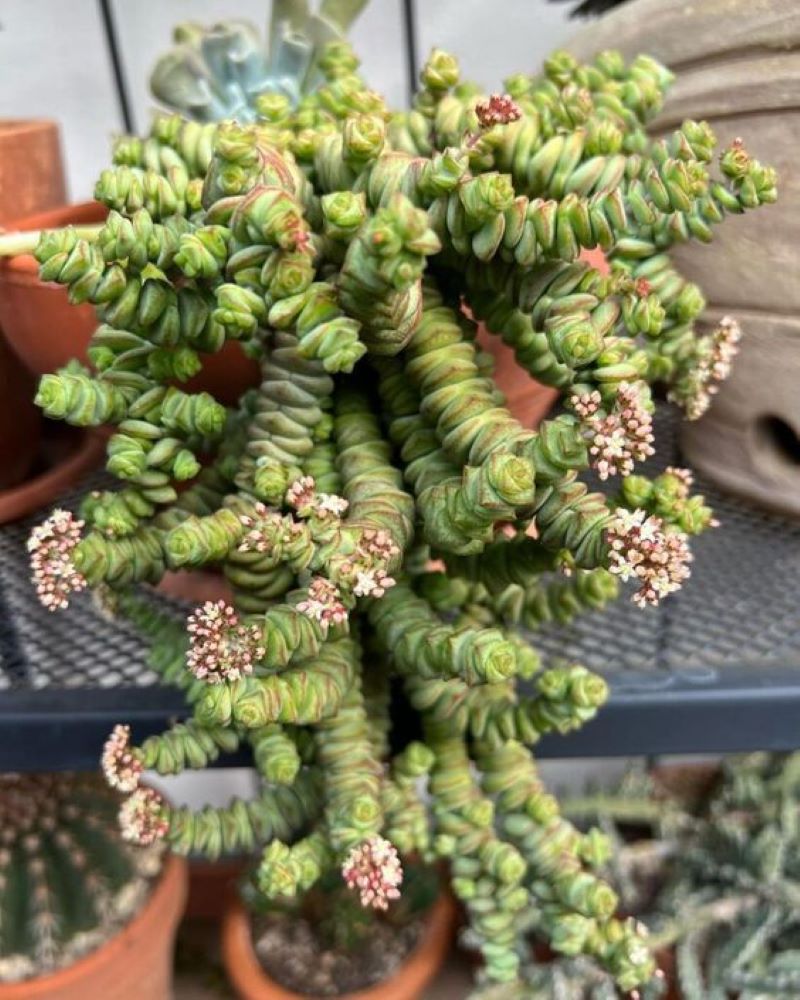
Hanging succulents can add a beautiful and unique touch to your home or garden decor. Here are some creative ideas for displaying hanging succulents:
Macrame Plant Hangers: Macrame hangers are a classic and stylish way to display your succulents. You can find various macrame patterns or even make your own to match your home’s aesthetic.

Vertical Wall Planters: Vertical wall planters are an excellent way to utilize wall space while showcasing a variety of succulent species. You can create a living succulent wall by arranging different planters vertically or using a modular system.

Hanging Terrariums: Glass terrariums with an open or closed design can make for a fascinating display of hanging succulents. Choose various succulent varieties that have different colors, textures, and shapes to create an eye-catching arrangement.

Repurposed Containers: Get creative with repurposed containers like old teapots, birdcages, or vintage containers. Just ensure the container has proper drainage to avoid overwatering.

Hanging Baskets: Traditional hanging baskets with coconut coir liners can work well for succulents. Line the baskets with moss or a plastic liner to hold in moisture while allowing for adequate drainage.
Succulent Chandeliers: If you’re feeling ambitious, you can craft a succulent chandelier using a wire or metal frame and attaching small pots or plant cuttings. Hang it in a covered outdoor space or as an indoor centerpiece.

Cascading Planters: Use tiered or cascading planters to create a waterfall effect with your hanging succulents. This allows you to showcase multiple succulents at different levels.
Hanging Glass Bulbs: Mini glass orbs or bulbs are a charming way to display individual succulent cuttings. They make for great window or patio decorations.

Floating Shelves: Install floating shelves on a wall or under a window to create a mini indoor garden with hanging succulents and other small plants.
DIY Hanging Plant Stand: Build a wooden or metal hanging plant stand that accommodates multiple pots or planters. You can customize the stand’s design to match your decor style.

Remember to choose succulents that have similar care requirements and ensure they receive adequate light and proper watering. Hanging succulents are not only visually appealing but can also save space and bring life to areas that might otherwise go unused. Enjoy the process of creating your hanging succulent displays!
Crassula tree and some things to know

Appearance: Crassula succulents typically have thick, fleshy leaves that store water. The leaf color can range from green to gray, and some species may have interesting patterns or red edges. They often have a compact, bushy growth habit, although some varieties may trail or form clusters.

Light: Most Crassula succulents thrive in bright, indirect sunlight. They can tolerate some direct sunlight, but excessive sun exposure can lead to leaf scorching. Provide them with at least a few hours of sunlight each day.

Watering: Water Crassula succulents thoroughly, allowing the soil to dry out between waterings. It’s important to avoid overwatering, as these plants are adapted to arid conditions. Watering frequency will depend on factors like temperature, humidity, and the specific species. Always check the moisture level of the soil before watering.

Soil: Crassula succulents require well-draining soil. A mixture of regular potting soil and perlite or coarse sand works well. It’s crucial to provide adequate drainage to prevent waterlogged roots.

Temperature and Humidity: Most Crassula succulents prefer moderate temperatures between 65-75°F (18-24°C). They can tolerate slightly cooler or warmer conditions, but prolonged exposure to extreme temperatures can stress the plants. These succulents generally prefer low to moderate humidity.

Fertilizer: Fertilize Crassula succulents sparingly during the growing season, typically from spring to summer. Use a balanced, water-soluble fertilizer formulated for succulents and follow the package instructions for application rates. Avoid over-fertilization, as it can lead to weak growth or damage to the plants.

Propagation: Crassula succulents can be propagated through stem cuttings or leaf cuttings. Allow the cuttings to dry and callous over for a few days before planting them in well-draining soil. Keep the soil slightly moist until the cuttings root.





